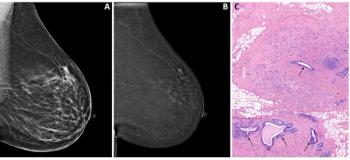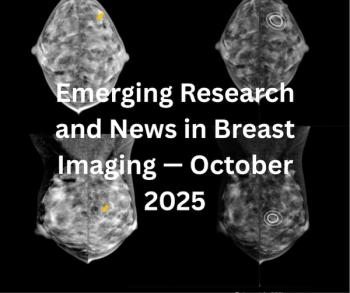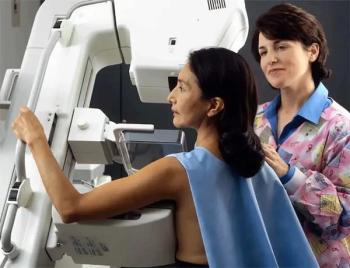
Contrast-enhanced mammography progresses with conventional media and digital flat panels
Five years have passed since the first full-field digital mammography unit was released, yet mammographers are only beginning to embrace the electronic capture of images. Still unrealized, but progressing faster than immediately obvious, is contrast media mammography (CMM), the use of contrast agents and FFDM to visualize the bed of blood vessels that typically accompanies the growth of cancer.
Five years have passed since the first full-field digital mammography unit was released, yet mammographers are only beginning to embrace the electronic capture of images. Still unrealized, but progressing faster than immediately obvious, is contrast media mammography (CMM), the use of contrast agents and FFDM to visualize the bed of blood vessels that typically accompanies the growth of cancer.
The Biosciences division of GE Healthcare, formerly Amersham, is developing a contrast agent specific to angiogenesis. The development effort, which is directed at mammography, has been given a high priority at GE. Its status ranks as an "imagination breakthrough," which the company uses to prioritize R&D projects.
"Breast oncology is one of the easiest and best places where we can apply the synergies of the former Amersham and GE Medical Systems," said Jean Hooks, GE's general manager for global mammography. "The team recognizes that the work done on the equipment side for the last several years is a perfect partnership with the knowledge that Amersham has in contrast media."
The effort to develop an angiogenesis-specific contrast agent is based on the understanding that cancer produces chemicals that stimulate the growth of blood vessels. The goal is to develop a medium that binds specifically with one or more of these angiogenesis factors, allowing the visualization of blood vessels associated with neoplasms.
Biosciences is working on this agent in conjunction with our contrast media mammography work," Hooks said.
A contrast product based on angiogenesis factors may be five or six years away, according to Hooks. But CMM using conventional iodinated contrast could be adopted sooner. Preliminary results show this technique to be more sensitive and specific than noncontrast-enhanced film or even digital mammography.
This approach is possible because the blood vessels surrounding neoplasms are defective. They tend to leak, causing contrast to pool in the area of the cancer.
In these studies, a precontrast image is used as a mask from which several postcontrast images are subtracted. Tissue found in both pre- and postcontrast images disappears, leaving images of contrast uptake and washout. Analyses of kinetic curves of enhancement often indicate the appearance of a hot spot early on, followed by progressively increasing enhancement.
GE staff meet with collaborators annually, usually at the RSNA meeting, and participate with them in monthly conference calls to keep tabs on their progress.
"There is very good clinical evidence (of efficacy) coming out of our CMM collaborators circle," Hooks said.
Early results presented to attendees of the 2004 RSNA meeting showed a strong correlation with invasive breast cancer. At the Institut Gustave-Roussy in Villejuif Cedex, France, 18 patients underwent biopsy and contrast enhancement visualized using the GE Senographe 2000D. Each patient had presented with a suspicious breast lesion. CMM was achieved with craniocaudal views acquired from 30 seconds to seven minutes after the injection of a 100-mL bolus of iodinated contrast medium.
Contrast enhancement occurred in 17 of 18 histologically proven invasive breast carcinomas. Enhancement was also observed in one instance of intraductal carcinoma. Analyses of kinetic curves showed early enhancement with washout in five patients, early enhancement followed by progressive enhancement in 10 patients, and gradual enhancement in two patients.
Research conducted at Sunnybrook and Women's College Health Sciences Centre in Toronto produced similarly encouraging results, with CMM identifying eight of 10 biopsy-proven cancers. It also indicated that only five of 12 patients identified with conventional mammography had suspicious lesions. The lower true-positive rates seen in this study of 22 patients suggests the potential for a significant reduction in false-positive findings and unnecessary biopsies, according to the Canadian researchers.
This high specificity of CMM was also seen at the Institut Gustave-Roussy, where no false positives were observed in the 18-patient study.
While results are encouraging, many details remain to be worked out regarding how this type of imaging should be performed. A study conducted at the Friedrich-Schiller-University in Jena, Germany, found that better results can be achieved when the breast is not compressed.
In that study, the group undergoing breast compression had just one false positive. The group whose breasts were not compressed using mammography paddles but only immobilized showed five false positives.
In the German study, which was reported at the 2004 RSNA meeting, 55 women with suspicious breast lesions were split into two groups. Both groups were examined using the Senographe 2000D, but one group underwent breast compression, while the other received only enough pressure to stabilize the breast.
In the group not undergoing breast compression, 15 of 18 cancers were identified, compared with three of 15 cancers found in the group undergoing breast compression. Eight of 13 patients were correctly documented as being negative in those patients not undergoing compression compared with eight of nine in the group undergoing breast compression.
One possible explanation for the disparity in results between those undergoing breast compression and immobilization is that compression may constrict blood flow. This may interfere with the flow of contrast and the enhancement that would otherwise occur.
Some of the difficulties may be resolved by improved imaging technologies. Many of the data have been obtained using an outdated version of the Senographe. GE luminaries will soon migrate to the Senographe 2000DS, which offers an improved image chain, including x-ray tube, detector, and gantry, according to Hooks.
The group of GE collaborators may also expand. Researchers in the U.S. are trying to organize a multisite clinical trial of CMM. Sites are now being recruited and the protocols defined, she said.
Newsletter
Stay at the forefront of radiology with the Diagnostic Imaging newsletter, delivering the latest news, clinical insights, and imaging advancements for today’s radiologists.






























